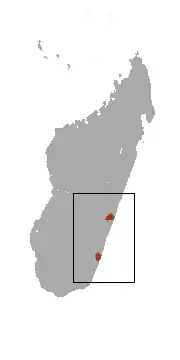Alison Jolly | |
|---|---|
| Born | Alison Bishop May 9, 1937 Ithaca, New York, United States |
| Died | February 6, 2014 (aged 76) Lewes, East Sussex, England |
| Nationality | American |
| Known for | Lemur biological studies |
| Spouse | |
| Children | 4, including Arthur |
| Scientific career | |
| Fields | primatology |
Alison Jolly (May 9, 1937 – February 6, 2014) was a primatologist, known for her studies of lemur biology. She wrote several books for both popular and scientific audiences and conducted extensive fieldwork on Lemurs in Madagascar, primarily at the Berenty Reserve, a small private reserve of gallery forest set in the semi-arid spiny desert area in the far south of Madagascar.
Biography
Born Alison Bishop in Ithaca, New York, she held a BA from Cornell University, and a PhD from Yale University; she had been a researcher at the New York Zoological Society, Cambridge University, University of Sussex, Rockefeller University, and Princeton University. In 1998 she was made Officer of the National Order of Madagascar (Officier de l'Ordre National, Madagascar). At the time of her death she was a visiting scientist at the University of Sussex.[1][2]
Under her maiden name, she first published "Control of the Hand in Lower Primates" in 1962.[3] Jolly began studying lemur behavior at Berenty in 1963[4][5][6] and was first to propose female dominance in a primate society. She encouraged field studies that contributed to knowledge about Malagasy wildlife and advised many researchers; she briefed Jane Wilson-Howarth and colleagues before their first expedition to Madagascar in 1981. Since 1990 Jolly had returned for every birthing season to carry out research assisted by student volunteers.[7] She focused on ring-tailed lemur demography, ranging, and especially inter-troop and territorial behavior, in the context of the fivefold difference in population density from front to back of the reserve.
Her scientific books include Lemur Behavior: A Madagascar Field Study, The Evolution of Primate Behavior and Lucy's Legacy: Sex and Intelligence in Human Evolution.[8] Her non-technical works include Madagascar: A World Out of Time and Lords & Lemurs: Mad Scientists, Kings With Spears, and the Survival of Diversity in Madagascar.[7] She also wrote numerous articles for consumer magazines and scientific journals.
Jolly was the author of two series of children's books—The Ako Books[9] and The Fiddle Stories.
Eponym

In June 2006, a new species of mouse lemur, Microcebus jollyae, was named in Jolly's honor.[10]
Personal life
The daughter of the artist Alison Mason Kingsbury and the scholar and poet Morris Bishop, in 1963 Alison Jolly married Richard Jolly, the development economist.[11] She died at home in Lewes, East Sussex, in February 2014 at the age of 76.[12][1] She is survived by her husband and their four children.
Publications
- Lemur Behavior: A Madagascar Field Study, University of Chicago Press, 1966
- The Evolution of Primate Behavior, 1972
- Play: Its Role in Development and Evolution, 1976
- A World Like Our Own; Man and Nature in Madagascar, Yale University Press, 1980
- Madagascar: A World Out of Time, 1984 with Frans Lanting & Gerald Durrell
- Madagascar, Key Environments Series, 1984
- Lucy's Legacy: Sex and Intelligence in Human Evolution, 1999
- Lords and Lemurs: Mad Scientists, Kings with Spears, and the Survival of Diversity in Madagascar, 2004
- Thank You, Madagascar: The Conservation Diaries of Alison Jolly, 2015
Children's books
- Ny aiay Ako (Ako the Aye-Aye), 2005
- Bitika the Mouselemur, (2012)
- Tik-Tik the Ringtailed Lemur, (2012)
- Bounce the White Sifaka, (2012)
- Furry and Fuzzy the Red Ruffed Lemur Twin, (2012)
- No-Song the Indri, (2012)
- Fiddle and the See-Throughs, (2013)
- Fiddle and the Flint-Boy, (2013)
- Fiddle and the Headless Horseman, (2013)
- Fiddle and the Falling Tower, (2013)
- Fiddle and the Smugglers, (2013)
- Fiddle and the Fires, (2013)
References
- 1 2 Vitello, P. (18 February 2014). "Alison Jolly, who found female dominance in lemurs, dies at 76". The New York Times. Archived from the original on 14 February 2015. Retrieved 20 February 2014.
- ↑ Richard, A. (19 February 2014). "Alison Jolly obituary". The Guardian. Archived from the original on 26 December 2014. Retrieved 26 December 2014.
- ↑ Peterson 2006, p. 285.
- ↑ Mertl-Millhollen, S. A.; Gustafson, H. L.; Budnitz, N.; Dainis, K.; Jolly, A. (1979). "Population and territory stability of Lemur catta at Berenty, Madagascar". Folia Primatologica. 31 (1–2): 106–123. doi:10.1159/000155875. PMID 114464.
- ↑ Jolly, A.; et al. (1982). "Population and troop ranges of Lemur catta and Lemur fulvus at Berenty, Madagascar: 1980 census". Folia Primatologica. 39 (1–2): 115–123. doi:10.1159/000156070. PMID 7141348.
- ↑ Jolly, A.; et al. (1982). "Propithecus verreauxi population and ranging at Berenty, Madagascar: 1975 and 1980". Folia Primatologica. 39 (1–2): 124–144. doi:10.1159/000156071. PMID 7141349.
- 1 2 Diller, F. (20 May 2008). "Scientists' Nightstand: Alison Jolly". American Scientist. Sigma Xi. Archived from the original on 11 November 2014. Retrieved 14 February 2014.
- ↑ Lambert, J. (2000). "Elegant Weave". American Scientist. Sigma Xi. Archived from the original on 11 November 2014. Retrieved 26 December 2014.
- ↑ "The Ako Project: The Ako team". Lemur Conservation Foundation. 2009. Archived from the original on 2014-12-26. Retrieved 26 December 2014.
- ↑ "Obituary: Dr Alison Jolly". University of Sussex. 14 February 2014. Archived from the original on 26 December 2014. Retrieved 26 December 2014.
- ↑ "Alison Bishop, Zoologist, Wed to Arthur Jolly", New York Times, 20 October 1963. Available via ProQuest.
- ↑ caowrites (11 February 2014). "In memory of Dr. Alison Jolly". Lemurconservationfoundation.wordpress.com. Lemur Conservation Foundation. Archived from the original on 22 December 2014. Retrieved 14 February 2014.
Literature cited
- Peterson, D. (2006). Jane Goodall: The Woman Who Redefined Man. Houghton Mifflin Harcourt. ISBN 978-0547053561. OCLC 64336038.
External links
- Alison Jolly at IMDb